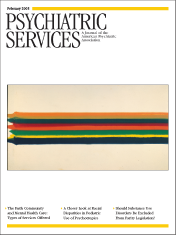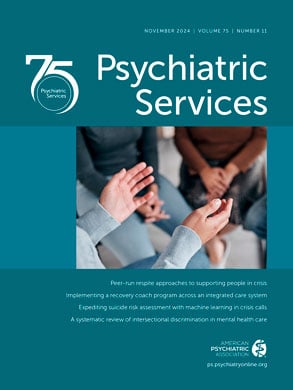Stalking involves repeated and persistent unwanted communications and contacts that create fear in the target. Mental health professionals may be at particular risk of becoming victims of stalking (
1). Psychiatric patients present with psychopathologic conditions that may make them more likely to become stalkers as a result of the associated loneliness, isolation, and disordered attachment patterns that predispose them to dysfunctional attempts to connect with others. This pattern of behavior can escalate to verbal threats and, in what Meloy (
2) calls "dramatic moments," usually after confrontation of the stalker about his or her behaviors, to actual physical assaults. Because often the stalking is driven by the psychopathology of the stalker, these occurrences can be a true psychiatric emergency.
Few studies have reported the cumulative incidence of stalking of mental health professionals. Romans and colleagues (
3), surveying 333 staff members of a counseling center in the United States, found a rate of stalking of 6 percent among 178 respondents. Sandberg and colleagues (
4) surveyed 62 members of staff from an urban university clinic inpatient unit and found that 8 percent had experienced obsessional following by patients (defined as "more than one overt act of unwanted pursuit that was perceived by the professional as being harassing") and that 3 percent had experienced stalking (according to the legal definition of being "willfully, maliciously, and repeatedly followed and harassed in a way that threatened the clinician's safety"). A recent survey of 238 North American psychologists found that 10 percent had experienced serious stalking events (
5).
We tested whether stalking was a recognizable problem for mental health professionals in Italy, where the concept of stalking has not yet attracted media attention and no specific law is available to prosecute this crime. We also measured the cumulative incidence of stalking, taking into account limitations of previous studies—namely, the use of nonoperationally defined definitions of stalking and the restriction to a category of professionals. We surveyed all 475 mental health professionals operating in the public and private sectors in the Italian province of Modena (population 600,000). The screening section of the 41-item questionnaire asked whether a patient had ever harassed the respondent in one of nine possible ways. Those who screened positive were also asked for detailed information about the characteristics of the stalker and of the stalking campaign. Stalking was operationally defined as the patient's making unwanted communications or contacts repeatedly (on more than ten occasions) and persistently (for a period of more than four weeks) such that the behavior produced some anxiety—or greater levels of anxiety according to the definition of Mullen and colleagues (
6). The study was conducted from September to November 2001.
There were 361 valid responses (76 percent). A total of 192 respondents (53 percent) were psychiatric nurses; 108 (30 percent) were psychiatrists, psychologists, or residents in psychiatry; and the remaining 61 (17 percent) belonged to other professional groups—for example, art therapists or educators involved in psychiatric rehabilitation. Having been harassed in one of the specified ways on at least one occasion was reported by 122 respondents (34 percent), and 40 (11 percent) met the above-mentioned definition for a stalking case (20 men and 20 women). Male professionals were more likely to be stalked (χ2=7.41, df=1, p=.006). In 15 instances the victims were psychiatric nurses; more psychiatrists and psychologists experienced extended periods of stalking (23 respondents or 58 percent of cases; χ2=17.29, df=2, p<.001). Older age, but not marital status, affected the likelihood of being a victim. The mean±SD age of the victims was 39±10.7 years (median, 37.5).
In 90 percent of cases the stalker was a client under the direct care of the clinician (N=35). The mean age of these stalkers was 36.2±11.6 years (median, 34). The stalkers were predominantly single (N=26, or 67 percent of known cases) and unemployed (N=21, or 58 percent of known cases). A primary DSM-IV diagnosis was reported for 38 stalkers. Seventeen stalkers (45 percent) had a psychotic disorder, four (11 percent) had a mood disorder, and 14 (37 percent) had a personality disorder, 13 of whom had a cluster B disorder. The median reported duration of stalking campaigns was 42 weeks (mean, 100; range, four to 780). The most common methods of harassment adopted by the stalkers were intrusive approaches (N=30, or 75 percent), telephone calls (N=26, or 65 percent), loitering near the victim (N=23, or 58 percent), maintaining surveillance (N=19, or 48 percent), sending letters (N=13, or 33 percent), following the victim (N=9, or 23 percent), violating property (N=8, or 20 percent), spreading gossip (N=6, or 15 percent), and sending unwanted material (N=4, or 10 percent).
Threats were made to nine clinicians (23 percent). Four of these received threats to their children and spouses, five reported damage to property, three were physically attacked by the stalker, and one was seriously injured. The most common emotional consequences for victims were fear (N=21, or 53 percent), anger (N=17, or 43 percent), and a sense of helplessness (N=11, or 28 percent). A substantial number of victims modified their lifestyle or professional style in response to the stalking behaviors: 14 (35 percent) took more precautions at work, seven (18 percent) had to change their personal telephone number, five (13 percent) increased their home security, three (8 percent) lost days at work because of being stalked, three considered changing their profession, two (5 percent) changed their work site, and one (4 percent) changed residence. A majority of victims sought assistance and counseling from colleagues (27 respondents, or 68 percent), family and friends (seven respondents, or 18 percent), police (six respondents, or 15 percent), and a lawyer (one respondent, or 3 percent).
The global cumulative incidence of stalking of 11 percent among mental health workers confirms previous hypotheses that these professions are at risk of this form of victimization (
7). Although stalking is not yet considered a social problem in Italy, the respondents in this Italian study were able to recognize and report the occurrence of this form of victimization, thus adding evidence to the transcultural viability of the construct of stalking. Furthermore, some of the results point to possibly specific features of stalking of mental health professionals. Contrary to surveys conducted in the general population, and closer to the findings of Gentile and colleagues (
5) with psychologists, male gender appears to increase the risk of being harassed by patients.
Psychiatrists and psychologists are the professionals most likely to be stalked, possibly because aspects of the psychotherapeutic relationship can produce misunderstandings about the nature of the intimacy generated and about appropriate boundaries in this type of relationship. Multicentric studies, conducted on an international scale, could show whether these findings held true across different countries with different characterizations of job tasks. For example, in Italy doctors usually function as primary care managers and have a high frequency of patient contacts.
As to the motivation for the stalking in this population, a majority of victims (N=17) reported patient's desire for more intimacy as the perceived motivation. In only five cases did the victim believe that the stalking campaign was initiated as revenge for a perceived wrong—for example, refusal to certify disability to enable the patient to obtain a pension. In three cases the stalking campaign was initiated after termination of the therapeutic relationship by the mental health professional, a situation that has analogous features to stalking after the break-up of a romantic relationship. Instances of overt threats and physical violence were low compared with those reported in forensic settings, where violent acts are experienced by 30 to 40 percent of victims (
8).
It is advisable that mental health professionals maintain high levels of attention to the maintenance of boundaries in working with patients; avoid confusion between personal and professional involvement; take seriously prodromal features that possibly herald the initiation of stalking, such as requests for personal details by patients; and report stalking incidents in team meetings or in supervision (for professionals working in private practice). On a policy level, the issue of harassment and stalking by patients needs to be addressed, taking into consideration the fact that even very inexperienced professionals such as residents are also at risk (in our sample, two out of 15). Further research on possible risk factors among patients and identification of characteristics of professionals who are victims could offer a better understanding of the phenomenon and suggest prevention strategies.

